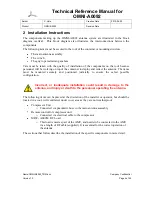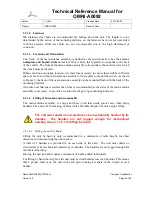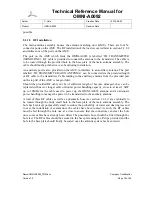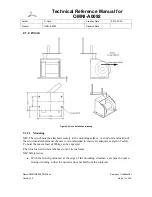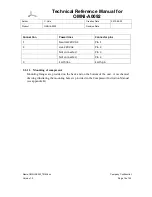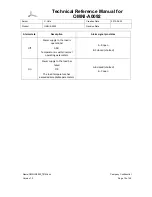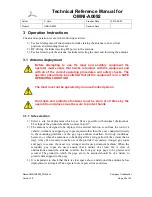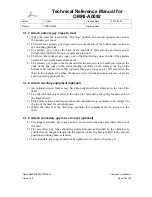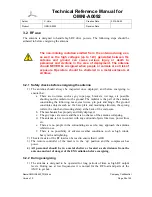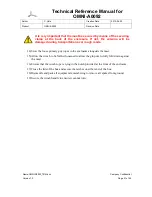
Technical Reference Manual for
OMNI-A0092
Author
C. Vale
Creation Date
2010-04-29
Product
OMNI-A0092
Revision Date
Name:OMNI-A0092_TRM.doc
Company Confidential
Version 1.0
Page 18 of 55
2.2.2.1.2
19” Rack mounting
The load has also been designed to fit a standard 19" racking system in which case the
detachable lower feet must be removed if the unit is mounted directly above other equipment
in the rack.
2.2.2.1.3
Other mounting options.
The feet on the back and bottom are screwed into mounting hard points. Brackets can be
designed to bolt to these hard points to facilitate other mounting configurations.
2.2.2.1.4
Mounting Considerations
The unit has two cooling fans that suck cooling air from the rear of the unit and blow it out
the sides. The installation must not obstruct the flow of cooling air.
2.2.2.2
RF installation
The load must be connected to the main antenna assembly AMU via a length of RF cable
(provided). The length of RF cable runs from the port on the AMU labelled „TO:
MATCHING LOAD‟ to the N-connector on the back of the RF load. The cable must be
routed through the hole on the base plate of the main antenna assembly and should not be
subjected to over-bending and pinching during installation.
The antenna should never be used at frequencies below 7 MHz if the
load is not attached. The load is necessary to provide adequate
antenna VSWR.
If a replacement or longer RF cable is required, then be sure to make use of cable rated for at
least 1.5kW power handling capacity up to 30MHz.
2.2.2.3
Powering up the load
The load must be powered up with 220 V AC via the IEC socket located at the back of the
unit. Power is required to run the cooling fans which are essential if the antenna is to operate
at full power for an extended period of time.
2.2.2.4
Alarm signal setup
The alarm status of the load can be determined from the ports of the multipin connector
located at the back of the unit.
There are 4 pins emerging from the connector, labelled „A‟, „B‟, „C‟ and „D‟. The labels are
embossed on the face of the connector.
The alarm states are described in the table below.

